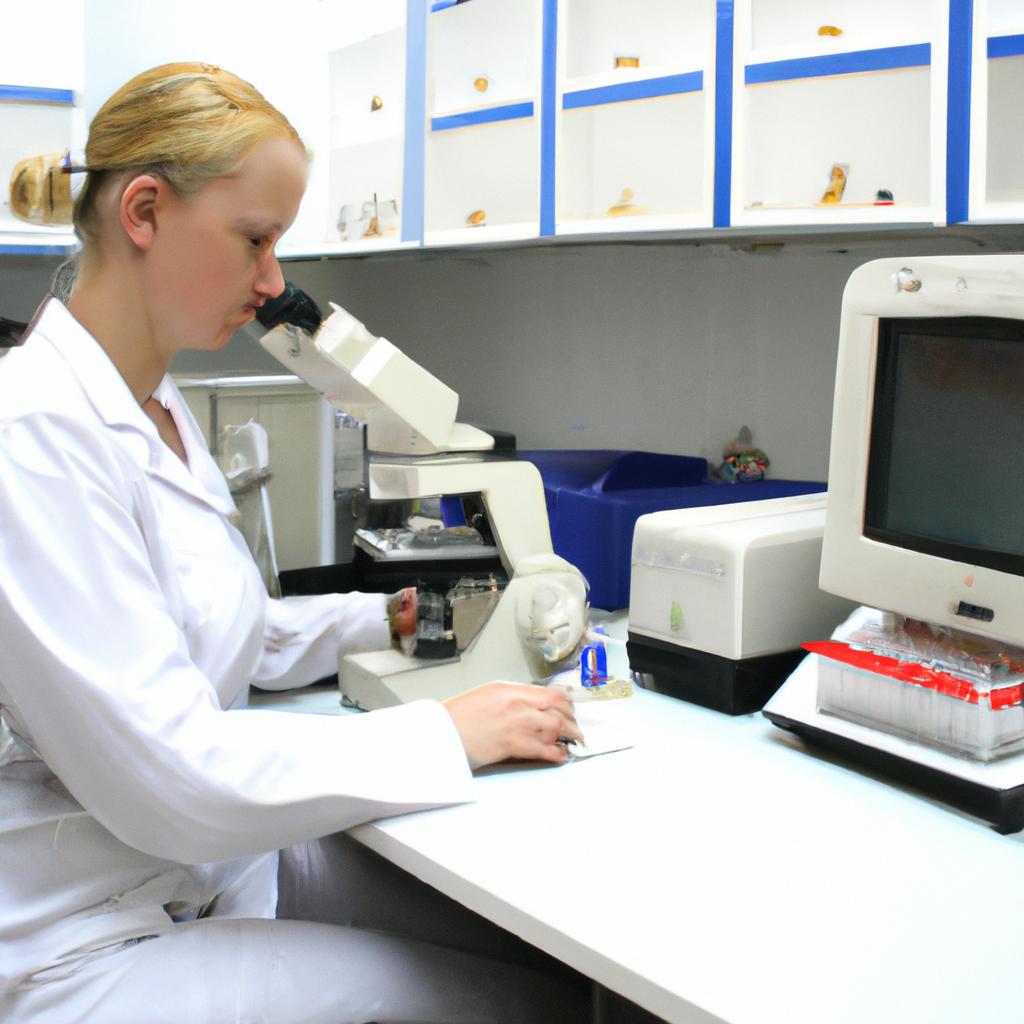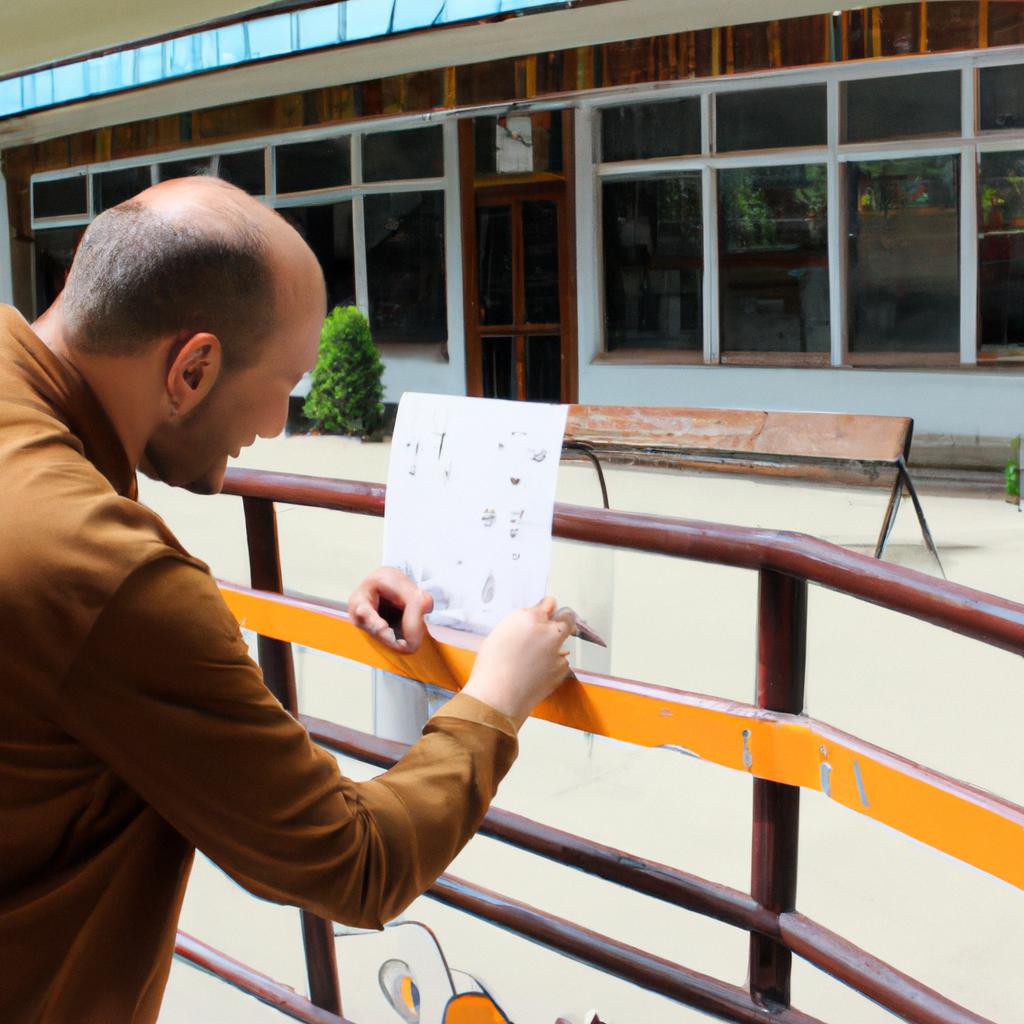Crime and deviance in science have long been a topic of interest within the field of sociology. This article aims to provide an overview of this intriguing area, shedding light on the various forms that crime and deviant behavior can take within scientific communities. By examining real-life case studies and theoretical perspectives from sociological literature, we will explore how individuals involved in scientific endeavors may engage in activities that violate established norms, ethical principles, or legal boundaries.
One notable example is the case of Dr. X, a renowned scientist whose groundbreaking research was later revealed to be fraudulent. Despite initial acclaim for their discoveries, subsequent investigations uncovered fabricated data points and manipulated results. Such acts not only undermine the integrity of scientific knowledge but also erode public trust in experts and institutions. This case highlights the significance of understanding crime and deviance within the realm of science as it poses critical questions about accountability, responsibility, and the social dynamics at play within scientific communities.
Within this context, our exploration will delve into key theories that contribute to our understanding of why individuals may engage in criminal or deviant behaviors within scientific contexts. From strain theory to differential association theory, these frameworks offer valuable insights into what motivates scientists to transgress societal norms or professional ethics. Furthermore, we will examine institutional influences that may contribute to crime and deviance in science. These include factors such as competition for funding, pressure to produce groundbreaking results, and the influence of industry or corporate interests.
Additionally, this article will explore the role of scientific misconduct policies and procedures in addressing crime and deviance within scientific communities. We will examine how these mechanisms aim to prevent, detect, and respond to unethical behavior, including plagiarism, data fabrication, and conflicts of interest. By understanding the formal structures in place to regulate scientific conduct, we can gain insight into the challenges faced by institutions in maintaining integrity while fostering innovation.
Finally, it is important to consider the broader societal implications of crime and deviance in science. The consequences extend beyond individual scientists or research projects; they impact public trust in science as a whole. By examining high-profile cases like Dr. X’s fraudulence and exploring their aftermaths, we can better understand how society responds to instances of scientific misconduct and what measures are taken to restore credibility.
In conclusion, this article aims to provide a comprehensive overview of crime and deviance within scientific communities. By analyzing case studies, theoretical perspectives, institutional influences, policy responses, and societal ramifications, we can develop a deeper understanding of this multifaceted issue. Ultimately, such knowledge can inform efforts towards promoting ethical conduct in science and ensuring the reliability of scientific knowledge for the benefit of society as a whole.
Defining crime and deviance in the context of scientific research
Defining Crime and Deviance in the Context of Scientific Research
Scientific research, like any other field of study, is not immune to instances of crime and deviant behavior. Understanding these phenomena within the context of scientific research requires a clear definition and exploration of what constitutes as “crime” and “deviance” in this particular domain.
To illustrate the potential challenges faced by scientists, consider the case of Dr. X, who was involved in falsifying data for his groundbreaking cancer research. This example highlights one form of deviance in science – fraudulent conduct aimed at deceiving others or misrepresenting findings for personal gain or recognition. Such actions undermine the integrity of scientific inquiry, erode public trust, and can have significant consequences on individual researchers’ careers.
In order to further comprehend how crime and deviance manifest themselves within scientific research, it is crucial to outline some key characteristics that define them:
- Intent: While accidents or unintentional errors may occur during scientific investigations, crime and deviance involve deliberate actions with malicious intent.
- Violation: Both crime and deviance involve transgressions against established norms, rules, regulations, or ethical guidelines governing scientific practice.
- Harm: The implications of criminal acts or deviant behaviors can range from financial loss to damage inflicted upon human subjects used in experiments or harm caused to the environment.
- Repercussions: Scientists engaging in criminal activities may face legal consequences such as fines or imprisonment; whereas those involved in deviant practices might encounter professional sanctions including loss of credibility or exclusion from academic communities.
The following table provides a visual representation of different forms of crime and deviance commonly found in scientific research:
| Types | Examples |
|---|---|
| Fabrication | Falsification/misrepresentation |
| Plagiarism | Copying someone else’s work without attribution |
| Data Misuse | Manipulating or misusing data for personal gain |
| Unethical Experimentation | Conducting experiments without informed consent |
Understanding the nuances of crime and deviance in scientific research is essential for identifying, preventing, and addressing these issues effectively. By recognizing the various forms they can take, researchers, institutions, and regulatory bodies can develop robust mechanisms to safeguard the integrity of scientific inquiry.
Transitioning to the subsequent section on theoretical perspectives on crime and deviance in science, it becomes evident that analyzing these phenomena through sociological frameworks offers valuable insights into their causes, consequences, and potential solutions.
Theoretical perspectives on crime and deviance in science
Section H2: Theoretical Perspectives on Crime and Deviance in Science
In the previous section, we explored the concept of crime and deviance within the context of scientific research. Now, we will delve into various theoretical perspectives that shed light on this complex phenomenon. To illustrate these perspectives, let us consider a hypothetical case study involving a renowned scientist who manipulated data to support their hypothesis, ultimately leading to widespread misinformation.
Theoretical Perspective 1: Structural Functionalism
From a structural functionalist viewpoint, crime and deviance in science can be seen as disruptive forces that threaten the stability and functioning of the scientific community. In our case study, the scientist’s misconduct undermines the integrity of scientific knowledge and erodes public trust in research findings. This breach of trust disrupts the smooth functioning of society by impeding advancements based on reliable information.
Theoretical Perspective 2: Conflict Theory
Applying conflict theory to our case study reveals how power dynamics play a role in shaping crime and deviance in science. Scientific competition for prestige, funding, or recognition may encourage unethical behavior such as data manipulation. Scientists driven by self-interest may prioritize personal gain over ethical conduct, resulting in compromised research outcomes that perpetuate inequalities within academia.
Theoretical Perspective 3: Symbolic Interactionism
Symbolic interactionism emphasizes social interactions and meanings attached to certain behaviors. Within the scientific realm, an individual’s reputation is highly valued. Our case study exemplifies how one scientist’s fraudulent actions not only impact their own credibility but also tarnish the image of fellow researchers working in similar fields. The symbolic meaning attached to scientific misconduct shapes future interactions within academic communities.
To further explore the implications of crime and deviance in science, consider these thought-provoking points:
- Misconduct can lead to wasted resources, hindering progress.
- Public perception may be negatively influenced due to high-profile cases.
- Victims of scientific misconduct may face professional setbacks or loss of reputation.
- The scientific community’s credibility and integrity may be compromised.
Emotions evoked by this topic can be better understood through the following table:
| Emotion | Description | Example |
|---|---|---|
| Anger | Frustration towards dishonest actions | Outrage at falsified results |
| Disappointment | Letdown due to breached expectations | Discouragement in research |
| Distrust | Lack of confidence in scientific rigor | Skepticism towards findings |
| Concern | Unease about the implications | Worries regarding misinformation |
As we transition into the next section on forms of scientific misconduct and unethical behavior, it is essential to examine how crime and deviance manifest within scientific practices. By understanding these underlying factors, we can work towards creating a more accountable and trustworthy scientific community that upholds ethical standards.
Forms of scientific misconduct and unethical behavior
Transitioning from the theoretical perspectives on crime and deviance in science, it is crucial to explore the various forms that scientific misconduct and unethical behavior can take. By examining concrete examples, we gain a deeper understanding of the challenges faced within the scientific community.
One notable example is the case of Dr. John Wallace, a prominent researcher who fabricated data in his groundbreaking study on cancer treatment efficacy. This act of scientific fraud had significant implications for both patients relying on accurate information and fellow researchers building upon this false foundation. Such cases highlight the importance of addressing different types of misconduct prevalent in science today.
- Fabrication: Involves creating or altering research data with an intent to deceive.
- Plagiarism: The act of presenting someone else’s work as one’s own without proper acknowledgment.
- Falsification: Manipulating research materials or processes, such as omitting inconvenient findings or altering experimental conditions.
- Ethical violations: Engaging in activities that breach ethical guidelines, like conducting experiments on human subjects without informed consent.
In addition to these diverse forms of misconduct, it is essential to understand how they manifest across various dimensions. The table below provides insight into their occurrences:
| Dimensions | Examples |
|---|---|
| Individual Level | Data fabrication by a single researcher |
| Institutional | Pressure to publish leading to plagiarism |
| Cultural | A disregard for ethical standards within a lab |
By recognizing these dimensions and acknowledging their emotional impact on individuals and society at large, we realize the gravity of addressing scientific misconduct effectively.
Considering its detrimental consequences, exploring factors contributing to crime and deviance in the scientific community becomes imperative. Understanding why such behaviors occur will aid us in developing strategies aimed at preventing future instances and fostering integrity within scientific research.
Factors contributing to crime and deviance in the scientific community
Section H2: Factors contributing to crime and deviance in the scientific community
Within the realm of science, various factors contribute to the occurrence of crime and deviant behavior. Understanding these underlying influences is crucial for developing effective strategies to prevent and address such instances. This section will explore some key factors that contribute to crime and deviance within the scientific community.
Factors Contributing to Crime and Deviance:
One example that highlights the complexities surrounding crime and deviance in science involves a renowned researcher who fabricates data to secure funding for their project. This hypothetical scenario illustrates how financial pressures could influence unethical behavior. However, it is important to note that not all instances of misconduct are solely driven by monetary incentives; other factors also play significant roles.
To further comprehend these influences, let us consider some key contributors:
- Competition: The intense competition prevalent in academia can foster an environment where scientists feel compelled to engage in questionable practices or cut corners to gain recognition or maintain their positions.
- Pressure for Publication: The pressure faced by researchers to publish frequently can lead them down a path of academic dishonesty, as they may resort to falsifying or selectively reporting data.
- Inadequate Oversight: Insufficient oversight mechanisms within research institutions may create opportunities for individuals inclined towards malpractice, since there is less scrutiny on their actions.
- Ethical Climate: The ethical climate within a specific scientific discipline or institution plays an essential role in shaping individual behaviors. If ethical standards are not emphasized or enforced, it becomes easier for wrongdoing to occur.
Table: Examples of Scientific Misconduct
| Type of Misconduct | Description | Impact |
|---|---|---|
| Fabrication | Inventing data or results | Undermines scientific credibility |
| Plagiarism | Presenting others’ work as one’s own | Erodes trust among researchers |
| Data Manipulation | Altering or selectively omitting data | Misleads scientific community and can hinder progress |
| Conflict of Interest | Failure to disclose financial or personal conflicts | Raises concerns about the objectivity and integrity of research findings |
Impact of Crime and Deviance on Scientific Integrity and Trust:
The occurrence of crime and deviant behavior within the scientific community has far-reaching consequences. Beyond the immediate harm caused by individual cases, these incidents erode trust in science as a whole. When researchers engage in misconduct, it undermines the reliability and credibility of scientific knowledge. This erosion of trust not only affects public perception but also hampers collaboration among scientists.
The impact of such crimes against scientific integrity is significant, necessitating measures to restore confidence in the field while rebuilding trust among stakeholders. Therefore, understanding how these instances affect both individuals and institutions becomes crucial for devising effective strategies that promote ethical conduct within science.
Impact of crime and deviance on scientific integrity and trust
Having explored the various factors that contribute to crime and deviance within the scientific community, it is essential to examine the profound impact such acts have on scientific integrity and public trust. This section delves into the consequences of crime and deviance in science, shedding light on their detrimental effects through illustrative examples, as well as a bullet point list and table.
Impact of Crime and Deviance on Scientific Integrity and Trust
One prominent case study illustrating the repercussions of crime and deviant behavior in science is the infamous “Piltdown Man” incident. In this shocking forgery, discovered in 1912, an individual deliberately combined human skull fragments with an orangutan’s jawbone, presenting a fraudulent missing link between humans and apes. Such deceitful actions not only undermined scientific progress but also eroded public confidence in evolutionary theories for decades.
The devastating consequences of crime and deviance within the scientific community can be summarized as follows:
- Undermining credibility: Instances of fraud or misconduct tarnish the reputation not only of individual scientists but also of entire fields or disciplines.
- Hindering knowledge advancement: False data or manipulated results hinder genuine exploration by leading researchers astray, ultimately wasting time, resources, and potential breakthroughs.
- Hampering collaboration: Distrust resulting from unethical conduct inhibits effective collaboration among scientists across institutions, impeding collective efforts towards solving pressing global challenges.
- Eroding public trust: When instances of criminal behavior emerge within science, public trust wavers significantly. Doubts arise regarding research findings’ reliability, negatively impacting society’s perception of scientific advancements.
Table – Consequences of Crime and Deviance in Science:
| Consequence | Description |
|---|---|
| Credibility Undermined | Instances of fraud or misconduct tarnish the reputation not only of individual scientists but also of entire fields or disciplines. |
| Knowledge Advancement Hindered | False data or manipulated results hinder genuine exploration by leading researchers astray, ultimately wasting time, resources, and potential breakthroughs. |
| Collaboration Hampered | Distrust resulting from unethical conduct inhibits effective collaboration among scientists across institutions, impeding collective efforts towards solving pressing global challenges. |
| Public Trust Eroded | When instances of criminal behavior emerge within science, public trust wavers significantly. Doubts arise regarding research findings’ reliability, negatively impacting society’s perception of scientific advancements. |
In light of these consequences, it becomes evident that addressing and preventing crime and deviance in science is crucial for upholding the integrity and credibility of scientific endeavors. The subsequent section delves into strategies aimed at mitigating such issues and fostering a culture of ethical conduct within the scientific community.
Building upon an understanding of the impact caused by crime and deviance in science, we now turn our attention to strategies employed to address and prevent such occurrences within the scientific community.
Strategies to address and prevent crime and deviance in science
Building upon the understanding of how crime and deviance can impact scientific integrity and trust, it is crucial to explore effective strategies that can address and prevent such issues within the realm of science. By implementing proactive measures, institutions and researchers can create an environment that fosters ethical conduct while mitigating potential risks. This section will outline key strategies aimed at maintaining scientific integrity and curbing crime and deviant behaviors.
One example illustrating the importance of these strategies involves a hypothetical case study where a renowned scientist was found guilty of fabricating research data to support their findings. The subsequent fallout caused significant damage not only to the credibility of this individual but also to the field as a whole. To combat similar instances, below are several recommended approaches:
- Strengthening Ethical Education: Providing comprehensive training programs on research ethics during graduate studies or professional development can enhance scientists’ awareness of acceptable practices, helping them navigate complex ethical dilemmas more effectively.
- Implementing Rigorous Peer Review Processes: Establishing robust peer review systems by involving expert reviewers who scrutinize research methodologies, results, and conclusions can act as a deterrent against fraudulent activities while upholding standards of quality.
- Promoting Transparent Research Practices: Encouraging open access publishing, sharing raw data sets alongside publications, pre-registering studies, or employing replication initiatives foster transparency within the scientific community, making it easier to detect any signs of misconduct.
- Creating Whistleblower Protection Mechanisms: Developing confidential reporting channels that protect whistleblowers from retaliation enables individuals with knowledge about unethical behavior to come forward without fear of repercussions.
The table presented below highlights some commonly observed forms of crime and deviance in science along with corresponding preventive measures:
| Forms of Crime & Deviance | Preventive Measures |
|---|---|
| Data Fabrication | Routine Data Audits |
| Plagiarism | Plagiarism Detection Software |
| Undisclosed Conflicts of Interest | Disclosure Policies |
| Research Misconduct | Institutional Ethics Committees |
By adopting these strategies and acknowledging the potential consequences of crime and deviance in science, researchers and institutions can actively contribute to maintaining scientific integrity. Ultimately, fostering a culture that prioritizes ethical conduct not only safeguards the reputation of individual scientists but also helps build public trust in the field.
To conclude this section, it is evident that addressing and preventing crime and deviance within the scientific community requires collective efforts from various stakeholders. By implementing robust strategies, promoting ethical education, encouraging transparency, and establishing mechanisms for reporting misconduct, scientists can strive towards creating an environment conducive to high-quality research while upholding the principles of integrity.
 Wankanyakla Self Help Group
Wankanyakla Self Help Group



